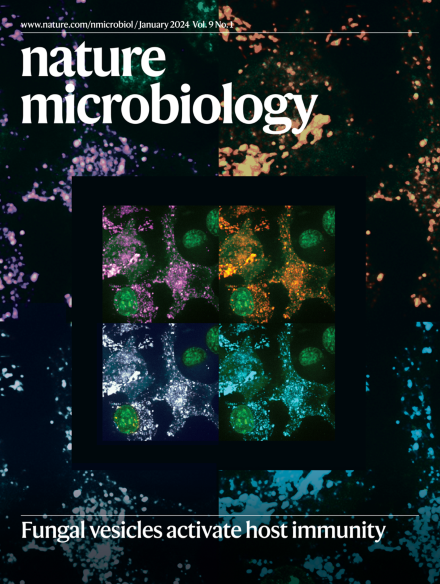Gamma-Mobile-Trio systems are mobile elements rich in bacterial defensive and offensive tools
IF 20.5
1区 生物学
Q1 MICROBIOLOGY
引用次数: 0
Abstract
The evolutionary arms race between bacteria and phages led to the emergence of bacterial immune systems whose diversity and dynamics remain poorly understood. Here we use comparative genomics to describe a widespread genetic element, defined by the presence of the Gamma-Mobile-Trio (GMT) proteins, that serves as a reservoir of offensive and defensive tools. We demonstrate, using Vibrio parahaemolyticus as a model, that GMT-containing genomic islands are active mobile elements. Furthermore, we show that GMT islands’ cargoes contain various anti-phage defence systems, antibacterial type VI secretion system (T6SS) effectors and antibiotic-resistance genes. We reveal four anti-phage defence systems encoded within GMT islands and further characterize one system, GAPS1, showing it is triggered by a phage capsid protein to induce cell dormancy. Our findings underscore the need to broaden the concept of ‘defence islands’ to include defensive and offensive tools, as both share the same mobile elements for dissemination. GMT-containing genomic islands in Vibrio parahaemolyticus and other diverse bacteria serve as a stockpile of immune and anti-phage defence systems, antibiotic-resistance genes and offensive tools such as type VI secretion system effectors.


Gamma-Mobile-Trio 系统是富含细菌防御和进攻工具的移动元件
细菌与噬菌体之间的进化军备竞赛导致了细菌免疫系统的出现,而人们对细菌免疫系统的多样性和动态性仍然知之甚少。在这里,我们利用比较基因组学描述了一种广泛存在的遗传元素,其定义是伽马-移动-三重(GMT)蛋白的存在,它是一种进攻和防御工具库。我们以副溶血性弧菌为模型,证明含 GMT 的基因组岛是活跃的移动元素。此外,我们还发现 GMT 基因组岛的载体包含各种抗噬菌体防御系统、抗菌六型分泌系统(T6SS)效应器和抗生素耐药基因。我们揭示了在 GMT 岛内编码的四种抗噬菌体防御系统,并进一步描述了其中一种系统 GAPS1 的特征,表明它由噬菌体外壳蛋白触发,诱导细胞休眠。我们的发现强调了扩大 "防御岛 "概念的必要性,以包括防御性和攻击性工具,因为这两种工具具有相同的传播移动元素。
本文章由计算机程序翻译,如有差异,请以英文原文为准。
求助全文
约1分钟内获得全文
求助全文
来源期刊

Nature Microbiology
Immunology and Microbiology-Microbiology
CiteScore
44.40
自引率
1.10%
发文量
226
期刊介绍:
Nature Microbiology aims to cover a comprehensive range of topics related to microorganisms. This includes:
Evolution: The journal is interested in exploring the evolutionary aspects of microorganisms. This may include research on their genetic diversity, adaptation, and speciation over time.
Physiology and cell biology: Nature Microbiology seeks to understand the functions and characteristics of microorganisms at the cellular and physiological levels. This may involve studying their metabolism, growth patterns, and cellular processes.
Interactions: The journal focuses on the interactions microorganisms have with each other, as well as their interactions with hosts or the environment. This encompasses investigations into microbial communities, symbiotic relationships, and microbial responses to different environments.
Societal significance: Nature Microbiology recognizes the societal impact of microorganisms and welcomes studies that explore their practical applications. This may include research on microbial diseases, biotechnology, or environmental remediation.
In summary, Nature Microbiology is interested in research related to the evolution, physiology and cell biology of microorganisms, their interactions, and their societal relevance.
 求助内容:
求助内容: 应助结果提醒方式:
应助结果提醒方式:


